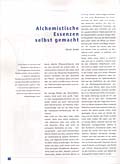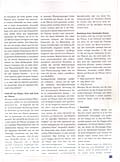|
||||||||
|
Alchemy & Paracelsus Medicine
Alchemistical Essences – Made at HomeThe plant tinctures used today are only initial substances of the genuine and ancient alchemistical essences. Only the elixirs prepared according to the teachings of Paracelsus contain all three healing powers of the plant – made from body, spirit and soul, or salt, sulphur and mercury. However, anyone can prepare such a plant essence by himself.By Ulrich Arndt The present desperate situation of the Public Health Care System
also holds a great opportunity. We are almost forced to recollect
our age-old knowledge of herbs, healing teas, herbal compresses
and the high art of preparing healing herbs, which is called alchemy. Healing Power gained from the Body, Spirit and Soul of the Plant With a genuine alchemistic plant essence you do not risk to produce
a questionable concentrate. On the contrary, the alchemistical
production process makes sure that you gain the healing powers
from the body, spirit and soul of the plant. This is by no means
to be understood in the philosophical sense: The healing powers
of the body are hidden in the salts of the plant and not contained
in an ordinary plant distillate or an alcoholic extract. The healing
powers of the soul are connected with the oil-containing substances
such as the essential oils. And the spiritual powers can be captured
with the inherent alkaloids or substances that are soluble in alcohol.
In alchemy, these three levels of the healing powers are called
salt, sulphur and mercury.1 Preparation of a Dandelion Essence
1. Extraction Now place the leaves, blossoms and roots separately in a tight-fitting
screw-cap container and add grappa so that all parts of the plant
are covered. The grappa
should have an alcohol content of at least 35 %; it is best to use an organic
grappa (grappa is a spirit made from the skins and husks of pressed grapes).
If you do not have a facility for drying the herbs, you can also place them
directly into the containers together with the alcohol. In the next step, each of the three preparations is processed separately. Therefore one obtains three different distillates. Pour the now green coloured grappa in the distillation container and dilute the total quantity with one-third to one-half spring water. Then add the extracted parts of the plant and simmer all at a low temperature, so that the grappa bubbles only slightly. If the entire liquid has almost completely evaporated into the container, put the drained parts of the plant in an old pan (without teflon or similar coating). Close the distillate tightly. 3. Calcination The drained parts of the plant from the distillation are now
burnt to ashes outdoor on an old camping cooker or in a pan on
a charcoal grill. In the beginning it produces a lot of smoke until
almost all moisture is evaporated. It will take quite some time
until the plant parts have turned into a white powder – so
don't lose your patience. This white powder contains the salt of
the plant, the saline healing principle. However, this salt must
still be cleaned, as it may contain toxic elements of the plant.
To do this, place the plant ashes in a container and pour some
distilled water on it. Swirl everything and let the liquid stand
for several hours. The soluble salts are dissolved in the distilled
water, the insoluble residue (ashes) remain at the bottom. Now
pour the ash water into a paper coffee filter or carefully pour
off the top liquid. The insoluble toxic and waste products of the
plant remain in the muddy ashes and will be thrown away afterwards. 4. Unification 5. Circulation The last step in the production process is unfortunately often
forgotten, although it can increase the energetic quality of the
essence even further. Pour the liquid in a tall, spacious glass
container that can be closed tightly and place it on the window
sill. More and more liquid will volatilise in the sunlight, condense
in the upper part of the container and run down along the inner
wall – the liquid is thus circulating n the container. In
this way, let the essence ripen for another moon phase, i.e. 28
days. By this process, the essence is filled with even more energy.
Application of the Dandelion Essence: The dandelion essence is now finished and can be used. If you have a plant preparation and not yet added further amounts, then take approximately 20–30 drops daily. When suffering from irregular digestion you can take 10 drops before every meal, otherwise in the evening before going to sleep. Since the liver and the gallbladder regenerate at night, this regeneration will be supported by the bitter constituents contained therein. Take the drops with some water or with a small sip of red wine, keep them in your mouth for a few seconds and then swallow.
1 see also article “The Determination of
the Alchemical Constitutional Type” in “Paracelsus – Health & Healing” issue
no. 4/II
|
Für weitere Informationen beachten Sie auch die Partnerlinks
Bitte beachten Sie:
Die Informationen dieses webs sind journalistische Aufbereitungen des
jeweiligen Themas und ersetzen keine medizinische Beratung. Bei
gesundheitlichen Problemen und Erkrankungen suchen Sie bitte zuerst einen
Arzt oder Heilpraktiker auf. |
|
|
| |
Home |Impressum |Datenschutz | Links | Bücher
& Seminare | Suche | | Heilmittel | Alchemie | Diagnose | Therapien | Selbsthilfe & Ernährung | Spiritualität & Wissenschaft | Urwissen | Denken & Handeln | Freizeit | |
| © horusmedia.de Ulrich Arndt Rechtliche Hinweise |
|
Bitte beachten Sie: Die Informationen dieses webs sind journalistische Aufbereitungen des jeweiligen Themas und ersetzen keine medizinische Beratung. Bei gesundheitlichen Problemen und Erkrankungen suchen Sie bitte zuerst einen Arzt oder Heilpraktiker auf. Ausdrücklich sei zudem darauf hingewiesen, dass in Artikeln eventuell beschriebene Methoden, Therapien, Hilfsmittel und Nahrungsergänzungen lediglich Hinweise und Verfahren einer alternativen, esoterischen oder traditionellen Erfahrungs-Heilkunde darstellen und keine Heilmittel und anerkannte Therapieformen im Sinne der heutigen Schulmedizin sind. copyright - Urheberrecht Rechtliche Hinweise Die Urheberrechte sämtlicher Texte liegen, sofern nicht ausdrücklich anders gekennzeichnet, bei Ulrich Arndt (im Folgenden der Autor genannt). Inhalte dürfen nur zu Informationszwecken und nicht zum Verkauf oder zur Verbreitung zu gewerblichen oder politischen Zwecken verwendet werden. Kein Artikel, kein Auszug aus einem der Texte, keine Grafik oder Bild dürfen ohne schriftliche Zustimmung des Autors in irgendeiner Weise vervielfältigt, verbreitet oder öffentlich wiedergegeben werden. Ohne schriftliche Einwilligung des Autors dürfen die Datenbank oder Teile von ihr auch nicht in von Datenverarbeitungsanlagen verwendbare Sprachen übertragen oder übersetzt werden und dauerhaft gespeichert. Ausgenommen hiervon sind nur Vervielfältigungen, die technisch zum Zwecke des Einblicks in die Datenbank unumgänglich sind und nur vorübergehend vorgenommen werden. Die Urheberrechte an Bildern und Grafiken liegen manchmal beim Autor, manchmal bei den Zeitschriften, in denen die Artikel erschienen sind, oder bei Dritten. Jegliche Nutzung bedarf der schriftlichen Zustimmung des jeweiligen Rechteinhabers. Der Autor behält es sich ausdrücklich vor, Teile der Seiten oder das gesamte Angebot ohne gesonderte Ankündigung zu verändern, zu ergänzen, zu löschen oder die Veröffentlichung zeitweise oder endgültig einzustellen. Markenrecht Alle in Artikeln eventuell erwähnten Marken- und Warenzeichen unterliegen uneingeschränkt den Bestimmungen des jeweils gültigen Kennzeichenrechts und den Besitzrechten der jeweiligen Eigentümer. Verwendungen bedürfen der schriftlichen Zustimmung des Marken- und Rechteinhabers. Links Einige Seiten dieser Website enthalten Links zu externen Websites. Diese Links ermöglichen Ihnen den Zugang zu weiteren Informationen bestimmter Themen. Trotz sorgfältiger inhaltlicher Kontrolle zum Zeitpunkt der Verlinkung übernimmt der Autor keine Verantwortung und Haftung für die Inhalte externer Links. Für den Inhalt der verlinkten Seiten sind ausschließlich deren Betreiber verantwortlich. Haftungsausschluss Der Autor hat die Informationen der Artikel nach seinem Stand des Wissens zum Zeitpunkt der Entstehung des Artikels und mit journalistischen Sorgfalt erstellt. Sollten sich dennoch unvollständige, fehlerhafte oder illegale Informationen eingeschlichen haben, so bittet der Autor um Entschuldigung, übernimmt aber keinerlei Haftung. Mit den Artikeln dieser Website sind keine Angaben und keine Gewähr zur Eignung der darin enthaltenen Informationen für einen bestimmten Zweck verbunden. So übernimmt der Autor keine Gewährleistung und Haftung im Zusammenhang mit jeglicher Nutzung der Informationen auf dieser Homepage, und in keinem Fall kann er haftbar gemacht werden für besondere oder indirekte Schäden, Folgeschäden, entgangenem Gewinn oder sonstige Handlungen, die aus Nutzung der Informationen resultieren. Sofern Teile oder einzelne Formulierungen dieses Textes der geltenden Rechtslage nicht mehr oder nicht mehr vollständig entsprechen sollten, bleiben die übrigen Teile des Dokuments in ihrem Inhalt und ihrer Gültigkeit davon unberührt. |


 2.
Distillation
2.
Distillation
